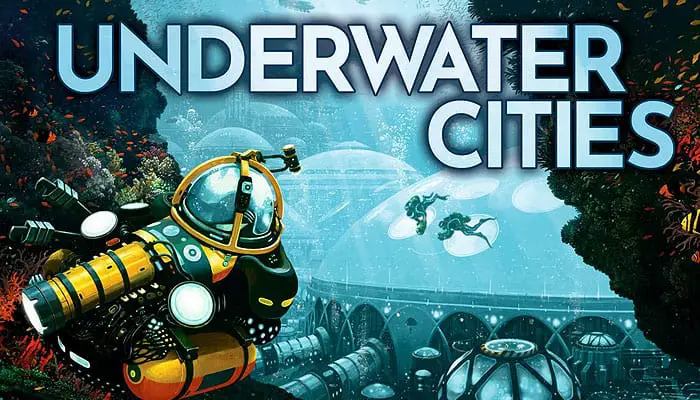
Players work to build underwater cities, a transportation network that connects them, and various facilities that support them. In each round, players take turns choosing an action while simultaneously playing a card.
If the card matches the color of the chosen action slot, the player also gains a benefit from the card. At three times during the game, players will deal with Production, a special phase in which their underwater network produces points and resources while their people consume food.
At the end of the game, additional points are awarded for various accomplishments and the player with the most points wins.
Components

- 1 game board
- 180 era cards
- 83 resource tokens
- 30 domes
- 47 tunnel tiles
- 16 metropolis tiles
- 111 structure tokens
- 4 player info cards
- 4 player boards
- 4 scoring cards
- 4 assistant cards
- 4 multiplier tiles
- 12 action tiles
- 1 action cloning tile
- 1 era marker
- 12 player markers
- 8 government contracts
- 25 special cards
- 35 credit tokens
- 1 rulebook
Order of Play
Two tracks determine the order of play. The play-order track shows the order of play for the current round. The Federation track is where players jockey for position for the next round.
For the first round, place the play-order markers on the play-order track randomly. Then, on the Federation track, the markers should be placed in the opposite order, as shown, and those who play third and fourth get additional resources. Specifically:
The player on space 1 of the play-order track will play first in the first round. On the Federation track, his or her marker will start below the track, on the space with the matching color.
The player on space 2 plays second. His or her other marker will start on space A of the Federation track.
The player on space 3 will also start on space 3 of the Federation track and will start with one extra credit.
The player who plays last will start on space 2 of the Federation track and will start with 1 credit and 1 steelplast in addition to the usual starting resources.
The first round is the only round that starts this way. In later rounds, play order and initial position on the Federation track will be determined differently.

Game Play
Here is a quick summary of how the game is played:
Players take turns choosing actions. They play in the order depicted on the play-order track, and this order does not change during the round.
You always start your turn with 3 cards. On your turn, you play one card and simultaneously choose one of the available action slots. That is, you choose a slot that no one else has chosen this round. (There is also a special slot, explained later, that is always available). You place one of your action tiles on the slot to indicate that you have chosen it. This makes the slot occupied and not available for the rest of the round.
If the color of the card you played matches the color of the slot you chose, you also get to perform the card's effect. If the color does not match, you just take the action and discard the card with no effect - you assigned some personnel to the job, but it was not their area of expertise, so they just did the job without accomplishing any additional tasks.
At the end of your turn, you always draw 1 card. It's also possible to draw additional cards as part of an action or card effect. If you end up with more than 3 cards, you will have to discard down to 3. You may discard any time before you take your next turn.
A Round
Players continue until each has taken 3 turns. As cards are played, slots will be occupied, making them unavailable for those who play later in the round. The number of available slots will diminish. When everyone has taken 3 turns, it is the end of the round.
The Era Marker
At the end of each round, the era marker advances one space along the era track. When it reaches a Production space, there is a Production phase.
Production
During Production, your underwater network will produce various resources. At the end of Production, each of your connected cities will consume 1 kelp.
An Era
An era consists of A rounds in Era I and 3 in Era II and Era III. The end of each Production phase marks the end of an era. New cards will come into play. The game has a different deck of cards for each era. At the end of Era III, the game is done.
Final Scoring
At the end of the game, players score various aspects of their underwater network, and the player with the most points wins.
Cards

The cards in your hand represent personnel you have at your disposal. On each turn, you will play one of these cards as you choose that turn's action. This represents sending your personnel out to complete that assignment.
You begin each turn with exactly 3 cards. During your turn, you play exactly 1 of these, while simultaneously choosing an action slot.
If the color of the card does not match the color of the slot, then you ignore the card and just perform the action. However, if the color matches, then you get to resolve the card before or after performing the action.
The three colors have different power levels:
- Green cards are the strongest, but you get their benefits only when you play them on green action slots, which are the weakest.
- Red cards and action slots have a moderate power level.
- Yellow cards are the weakest, but the yellow action slots are the strongest.
Some cards have an instant effect. All others can be claimed for later use, as explained below. All five types of cards are described in this section.
Instant Effects

When you play a card with this symbol, if its color matches your chosen action slot, you resolve the card's effect immediately before or after you perform your chosen action. If the color does not match, you ignore the card's effect.
In either case, these cards are discarded to the discard pile on the main board.
Claiming a Card
Four types of cards do not have instant effects. When you play such a card, if its color matches your chosen action slot, you claim the card by placing it near your player board. It thus becomes a permanent part of your underwater nation.
If the color of the card does not match the color of the slot, you cannot claim the card. It goes to the discard pile.
Permanent Effects

Cards marked with this symbol have a permanent effect. You gain the card's benefit if you claim it, as described above. Permanent effects take various forms. Some permanent effects trigger whenever a certain event happens.
Others might give you a discount in certain situations. Some offer a special ability that you can use every turn. It is legal to use the permanent effect even on the turn in which you claim the card.
Action Cards

Cards with this symbol are action cards. Your claimed action cards offer additional actions your underwater nation can perform. To use an action card, you must use an action slot or a card effect that allows you to do so.

Example: If you choose this action slot, you may use one of your action cards and gain 1 steelplast.

Example: If you play this instant-effect card on a green slot, you may use one of your action cards before or after performing the slot's action.
It is legal to use an action card even on the turn in which you claimed it.
Each action card is limited to one use per era. After use, rotate it 90 degrees to the right to show that it has been used and is no longer available. At the end of the era, after Production, all action cards are restored to the usual orientation to show that they will be available again in the new era.
Note: There are a few instant-effect cards which allow you to make an used action card available again. This can allow you to use an action card more than once in the same era.
Limit of Four
You are limited to A action cards (and your Personal Assistant [see on the top] counts as one of the 4). If you already have 4, then you must discard one before you claim a new action card. The discarded card can be one that has been used this round or one that is still available.
If you make room for a new action card by discarding one that is available, you may immediately use the discarded action. It is as though your new action card also came with an instant effect that lets you use the discarded available action card.
Personal Assistant

During setup, each player received a Personal Assistant. This is an action card that is already claimed and in play at the beginning of the game.
It follows the same rules as any other action card.
When you use the action, you decide whether to gain 1 steelplast or 1 credit.
It could also be discarded within the "Limit of four" rule.
Production Cards

Cards with this symbol are production cards. Your claimed production cards take effect during the Production phase, which happens three times during the game. Some produce resources directly. Others may modify your production based on what is connected to your network.
End-scoring Cards

Cards with this symbol are end-scoring cards. Your claimed end-scoring cards can give you points at the end of the game. Some give you points based on some aspect of the network you have built. Others may allow you to convert certain resources to points.
Special Cards

The cards you draw from the regular deck are unknown to you until you draw them. But some cards start the game face up for all to see. These are called Special cards.
Special cards cannot be drawn in the usual way. The only way to get one is to use the action slot marked like this.
The Special card remains in your hand. It can be played just like any other card. If it does not match your chosen action slot, then it is discarded and returned to the bottom of the Special card deck with no effect. If it matches, then it has an effect only if you pay the cost depicted near the upper left corner.

Example: The player must pay 3 credits to play this card if she wants its special benefit.
Discarding Special Cards
When one- or two-credit Special cards are discarded (for example, when you are discarding down to your hand limit) they should be immediately returned to the bottom of the Special card deck.
When you play a one- or two-credit Special card:
If the color does not match the chosen action slot, return the card to the bottom of the Special card deck.
If you choose not to pay to play the Special card, return it to the bottom of the Special card deck.
If the color matches and you pay to play it, then you keep it. If it has an instant effect, keep it under your player board after performing the effect to ensure that it will not re-enter play. If it is not an instant-effect card, claim it in the usual way.
Three-credit Special cards have no way to re-enter play. Generally, they are too valuable to discard, but if one is discarded, you can return it to the box.
Action Slots and Card Effects
On your turn, you choose an action by placing one of your action tiles on an action slot. Slots that have already been chosen this round are occupied and cannot be chosen again. Slots that have not yet been chosen are available.
The two sides of the main board have different action slots. One side is designed for a two -player game. The other side is designed for three or four.
When you place your tile on an action slot, you must also play a card from your hand. The action slots and the cards come in three colors. If the color of your card matches the color of the action slot, you may resolve the card's effect before or after you perform the slot's action. If the colors do not match, you ignore the card and only perform the slot's action.
It is legal to use only part of an action or card effect. For example, if an action slot allows you to build a city and a tunnel, you can choose to build only the tunnel, if you wish.
However, you are not allowed to choose an action slot without using at least part of its effect. For example, if you do not have enough resources to build 1 tunnel, you cannot choose the action slot that allows you to build 2 tunnels.
Card effects are always optional, so it is legal to play a matching card and not use its effect at all.
In this section we will illustrate core gameplay concepts with action slots, but these rules also apply to many of the card effects as well.
Resources
Underwater Cities has many resources that players can gain or spend.
The gaining of a resource is represented by a simple icon:
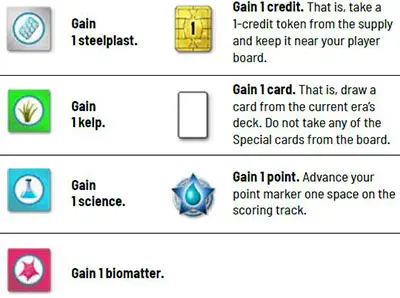
In general, credits, science, kelp, steelplast, and biomatter are used to pay costs. Kelp is also used for feeding your people (there are other ways to feed people, but kelp is the most efficient). Cards, of course, are useful because they give you more choices on your turn.
And points are how you win the game. So anything you gain is sure to be useful to you sooner or later.

Example: The player who chooses this action slot will take 2 steelplast tokens and 1 kelp token from the supply and keep them near his or her player board.

Limited and Unlimited Components
-
Credits, kelp, steelplast, science, and biomatter tokens are not intended to be limited.
If the supply runs low, you can use higher denominations and the multiplier tiles to represent the amount of resources you have. You can make change freely at any time.
-
Building tokens are not intended to be limited. If you run out of a particular type, you can usually substitute a different colored token. For example, if players have lots of upgraded farms, the supply might run out of green tokens.
You can get more in the supply by replacing the bottom tokens of some upgraded farms with a color you have lots of. The green token on top is sufficient to remind you that it is an upgraded farm. -
Tunnels and nonsymbiotic cities are limited.
The supply starts with 47 tunnels. When they are gone, no one can build tunnels anymore. Similarly the game has only 17 nonsymbiotic city domes, and no more than this may be built.
-
Symbiotic cities are limited. The limit depends on the number of players:
- In a two-player game, use 7 symbiotic city domes.
- In a three-player game, use 10.
- In a four-player game, use all 13.
-
The era deck is not limited. If it runs out of cards, shuffle its discard pile to make a new deck.
-
You should not run out of one- or two-credit Special cards. Whenever these are "discarded" they return immediately to the bottom of the deck.
-
Three-credit Special cards are limited. Only six are available in the game.
Cities
Cities provide the habitat for the people of your underwater nation. At the end of the game, every city connected to your network will be worth points. There are 2 types of cities.
Build a city:

Pay 2 steelplast, 1 kelp and 1 credit for a nonsymbiotic city (white dome);

or pay 1 steelpast, 1 kelp, 1 biomatter and 2 credits for a symbiotic city (purple dome).
When you build a city, pay the usual cost and take the corresponding dome from the supply. Place the dome on an empty city site on your player board. The site you choose for your new city must be adjacent to an existing city.
In other words, the new city must have a tunnel site that could connect it to an existing city. It is legal to build new cities before building the connecting tunnels.
Symbiotic cities are a little more expensive (biomatter is difficult to get) but they can produce points during Production. Nonsymbiotic cities are a little easier to build (if you have the steelplast) but they do not produce points. Both kinds of cities can give you points at the end of the game, and both require kelp to feed them at the end of Production. Whenever a rule or effect applies to a city, that means "a symbiotic or nonsymbiotic city".

Expansion Sites
Each city has an additonal building site that is generally off limits. You can build on this site only if you play a card with an effect that specifically allows you to build on an expansion site (and only if it is adjacent to an existing city or a site on which it is legal to build a new city).
Costs
The usual cost for building a city, building, or tunnel is depicted on your player info card. This is the cost you pay when you build something by choosing an action slot.
Certain card effects also allow you to build things. If the card does not specify a cost, you pay the usual cost. However, if the card specifies a cost, you pay that cost instead of the usual cost.
Buildings
Buildings are special facilities that help to make your underwater nation self-sufficient. You can build 3 types of them:

- Build a farm. This costs 1 kelp.
- Build a desalination plant. This costs 1 credit.
- Build a laboratory. This costs 1 steelplast.
When you build a building, pay the cost (which is depicted on your player info card) and take a token of the corresponding color from the supply. Place the building token on an empty building site. The site you choose for your new building must be adjacent to an existing city or adjacent to a site on which you could build a new city.
The different buildings produce different things during Production. They will produce more if they are upgraded.
Also, certain cards may have a conditional effect that only applies if you have certain buildings. Buildings have none of these beneficial effects until they are connected to your network. To connect them, you will need to build tunnels and cities.
Tunnels
Tunnels connect your cities to your underwater network.

Build a tunnel. This costs 1 steelplast and 1 credit.
When you build a tunnel, pay the cost and take a tunnel tile from the supply. Place it on a tunnel site with the non-upgraded side up. The tunnel in the illustration above is non-upgraded.
The site you choose for your new tunnel must be connected to your starting city. Tunnels are connected if you can trace a path along the tunnels back to your starting city. The path can go through cities or through empty city sites, but not through empty tunnel sites.
Step-by-step Expansion
You build your tunnels, buildings, and cities one-at-a-time. For example, if you choose this action slot, you first build one tunnel on a legal tunnel site and this could open up one or more new legal sites for the second tunnel.
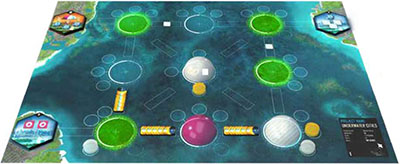
Example: The cities, buildings, and tunnels on this player board have all been built legally. Possible sites for the next new city are highlighted in green. If the player were to build a city in the upper left corner, then the remaining two city sites would immediately become legal to build on.
The city site in the lower left corner is a legal site for a new city. Therefore, its empty building sites are legal sites for new buildings. The player has already built a [laboratory] on one of these building sites.
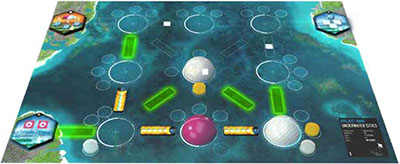
Example: Legal sites for a new tunnel are highlighted in green. Note that all three existing tunnels are connected to the starting city, as required.
Your Network
We have seen that tunnels must be connected to your starting city, but buildings and cities do not have to be. This gives you freedom in how you choose to expand. However, you eventually want everything on your board to be connected to your network.
Your network is all the structures and cities and empty city sites that are connected to your starting city:
- By definition, your starting city is always connected to your network.
- All your tunnels are automatically connected to your network because building a tunnel that is disconnected is not legal.
- A city is connected to your network if there is a chain of tunnels from it to your starting city. Because all your tunnels are connected, any city with a tunnel leading to it is connected and a city with no tunnels is not connected.
- A building adjacent to a connected city is connected to your network.
Buildings and cities that are not connected do not produce during Production. They do not consume kelp at the end of Production. They do not count during final scoring.
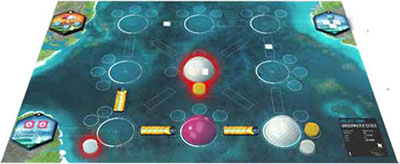
Example: The city in the middle and its building are not connected because there is no tunnel leading to the city. The building in the lower left corner is not connected because it has no city. Everything else is connected and thus part of the network.

Biomatter is a remarkable substance, somewhat more rare than the other resources. In addition to being essential for building symbiotic cities, biomatter can also be a universal building material. Only when building a tunnel, building, or city, any part of the cost that requires kelp or steelplast can be paid with biomatter instead.
Example: A nonsymbiotic city normally costs 2 steelplast, 1 kelp, and 1 credit. But you could build it with 1 steelplast, 2 biomatter, and 1 credit.
Upgrading Structures
Buildings and tunnels are called structures in this game. Structures are different from cities in that structures can be upgraded. There is a card that will let you turn a nonsymbiotic city into a symbiotic city, but this is an exception.
To upgrade, you need a card or action slot with a depiction like this:
 Upgrade 1 structure. Pay 1 science.
Upgrade 1 structure. Pay 1 science.
Whether upgrading a tunnel, a farm, a desalination plant, or a laboratory, the usual cost is 1 science. However, the card effects offer you special cost opportunities.
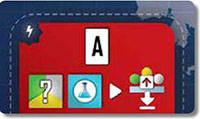
Use 1 of your action cards. Pay the usual cost to build a structure. Pay 1 science to upgrade the structure you just built. [3-4 players]

Gain 2 science; or upgrade 1, 2, or 3 structures, paying 1 science for each upgrade. The structures do not all have to be the same type. [1-4 players]
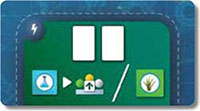
Gain 2 cards. Upgrade 1 structure by paying 1 science or gain 1 kelp. [2 players]

When you upgrade a building, take the corresponding token from the supply and stack it atop the structure you are upgrading. To upgrade a tunnel, flip the tile over to the upgraded side.

An upgraded tunnel still counts as a tunnel, an upgraded farm still counts as a farm, etc. It is not possible to upgrade any structure that is already upgraded.
Upgraded structures produce more during Production, and certain cards may provide benefits for having upgraded structures.
The Federation Track
We have explained how to build your underwater nation, but you also need to build a good reputation with the world government! You do that by choosing actions or playing cards with this symbol:
 Advance 1 space on the Federation track.
Advance 1 space on the Federation track.
Before the first round, players' markers are placed on separate spaces of the Federation track in reverse play order. At the beginning of subsequent rounds, the markers begin below space 4.
When an action slot or card effect allows you to advance 1 space on this track, move your marker 1 space ahead. If there is a bonus depicted beside that space, immediately gain the depicted resource. If you move ahead more than 1 space, gain the bonus of each of those spaces.
If your marker ends up on an occupied space, place it atop the other markers which are already there (being atop other markers means you will play ahead of them in the next round).
Even when you have advanced as far as possible, you can still gain benefits from "advancing" more. If you advance when you are already on space 1, put your marker atop any others on space 1 and score 1 point for each space you were supposed to advance.
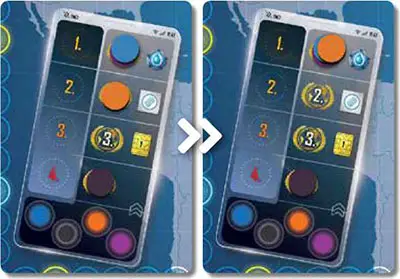
Example: Orange takes an action allowing her to advance 2 spaces. She moves ahead only 1 space, because that is the end of the track. However, she scores 2 points: 1 for moving onto that space and 1 for "advancing" off the track. Her marker is placed atop any other markers that are already on space 1.
Drawing Special Cards

This symbol indicates that the action slot allows you to take a Special card. Many Special cards are available face up in the center of the game board.
When you take a Special card, you either:
Take one of the three-credit Special cards (it is not replaced).
Or take the top card from the deck (the one-or-two-credit deck) and turn the next card face up.
Or turn the top card face down, move it to the bottom of the deck, and draw the next 3 cards. Choose one of these 3 to keep and return the other 2 to the bottom of the deck in either order. Then turn up the new top card.
Once a Special card is in your hand, it is mostly like any other card.
Using Action Cards
Action cards are a certain type of card you claim and keep near your player board. They have actions which can be used during the game, but only when you use an action slot or a card effect with this symbol:
 You may use 1 of your action cards.
You may use 1 of your action cards.
The Always-available Slot
One action slot is always available, even if another player has already chosen it this round. It has no color, so when you choose it you ignore the effect of the card you play.
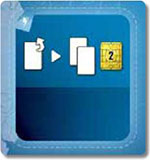
The always-available slot allows you to gain 2 cards and 2 credits.
Note: Some Special card effects allow you to use the action depicted at an action slot. These effects apply only to the colored slots, not to the always-available slot.
The Action-cloning Tile (4 Players)
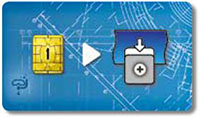
In a four-player game, the important action slots become occupied quite quickly. The action-cloning title (which is available only in a 4-player game) gives players a second chance at one of these slots.
On your turn, instead of choosing an available action slot, you may do the following:
- Pay 1 credit.
- Take the action-cloning tile.
- Choose an action slot occupied by another player.
Your action tile goes on the slot you chose, on top of the other player's tile. You also play a card, as usual, and you gain the benefits of the card if its color matches the chosen slot. Note that you cannot choose a slot that is already occupied by your tile.
Note on card effects: In a four-player game, "any slot occupied by another player" actually means "any occupied slot not occupied by you". The idea is that if you have already placed a tile on that slot, a card that allows you to use "any slot occupied by another player" will not allow you to use that slot again. So a slot occupied by you and another player does not count as a "slot occupied by another player".
One-time Use
Once the action-cloning tile is used, it cannot be used again for the rest of the round. The player who used the tile keeps it as a reminder that this option is no longer available. The tile is returned to its place on the main board at the end of the round.
Timing
Some effects have multiple parts. The parts of an effect can be resolved in any order.
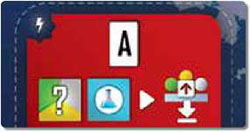
This action allows you:
- Use one of your action cards
- Build a structure for its usual price
- Pay 1 science to upgrade just built structure
We have already mentioned this action and it means, that you may build any structure for its usual price and then to upgrade it immediately by paying 1 science. In addition you can use one of your action cards.
According to the order of playing individual parts of this action, you can first use an action card which gives you for example 1 credit and then you can pay this credit and 1 science to build and immediately upgrade desalination plant.
Be careful!! You must resolve all card effects and then all actions from an action slot or vice versa. Resolving these 2 sets of actions simultaneously is not allowed.
Bonuses From Building
Your player board depicts certain bonuses you may gain from building. Every board offers different bonuses. When you build a structure or a city on a site marked with a resource, you gain the resource.
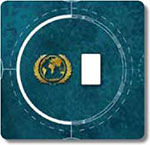
Building on a site marked with this symbols allows you to advance 1 space on the Federation track and draw one card from current Era deck.
You gain the bonus even if the city or building you build on that site is not yet connected to your network. These bonuses are triggered effects, which are resolved immediately, even in the middle of an action:

Example: Suppose you can legally build on the site shown here. You choose the action that allows you to build 2 tunnels. You pay 1 steelplast and 1 credit to build on this site and immediately gain 1 steelplast.
You may use this steelplast (and 1 more credit) to build your second tunnel.
Metropolises
You also gain benefits from expanding your network out to connect with coastal metropolises.
To connect this metropolis, you need to build a tunnel on the adjacent tunnel site.
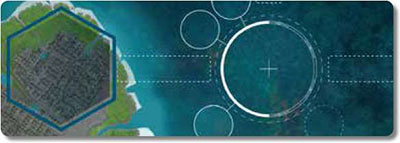
To connect this metropolis, you need to build tunnels on both adjacent tunnel sites.
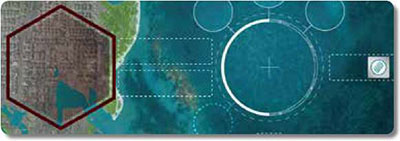
The metropolis tiles offer various benefits that apply only if the metropolis is connected. Your brown metropolis can give you points during final scoring. The blue ones either have an instant effect or an instant effect and a production effect.
End of Turn
At the end of your turn you always draw 1 card. This is in addition to any cards you may have acquired during your turn. Because you played only 1 card, you now have at least 3.
If you have more than 3 cards, you must discard down to 3. However, you can think about this decision while others are playing. Officially, this decision is made at the beginning of your next turn. In practice, it is okay to discard as soon as you have made up your mind.
End of the Round
During the course of one round, each player will get three chances to play a card while choosing an action slot. The action slots will fill up with action tiles. At the end of the round, everything needs to be reset.
-
Return all action tiles to their owners.
4 players: In a four-player game, the player who took the action-cloning tile should return it to the middle of the table at this time.
-
Reorder the play-order markers according to the order of the markers on the Federation track. The player farthest ahead on the Federation track will go first next round. The next player will go next, etc.
If markers are in a stack, each marker is ahead of any markers below it. Among markers below space A, relative play order does not change.
-
Once you have determined the next round's play order, place all Federation track markers on the colored spaces below space A.
-
Advance the era marker. If this is the end of the era, there will be a Production phase before the next round.
Note: Be sure to determine the new play order even if this is the end of the final round. This final order is the tie-breaking order.
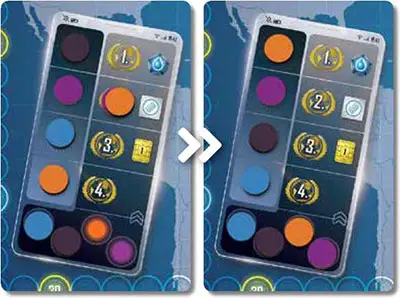
Example: It is the end of round 2. Black and Blue did not advance on the Federation track, so they will go last in round 3. Their relative order does not change, so Black will play ahead of Blue. On space 2, the tiebreaker is the order of the stack. Because Orange is on top, Orange will go first.
Production
Timing Overview

The era marker moves one space on the era track at the end of each round. After A rounds, it will move onto a Production space, reminding you that it is time for your first Production phase.
The second Production phase happens 3 rounds later. The final Production phase happens 3 rounds after that, just before final scoring. In all, you will play 10 rounds and have 3 Production phases. Each Production phase marks the end of an era.
Your Network's Production
All players can handle their Production simultaneously. Every tunnel adjacent to a city and every building in your network will produce something. Upgraded structures will produce more. Symbiotic cities will produce 2 points!
Nonsymbiotic cities have no production of their own, but they are still useful because they connect buildings to your network.
You also gain a slight production bonus when you have 2 upgraded buildings of the same type at the same city.
The production of your network is depicted on your player info card.
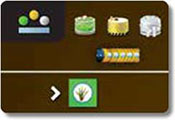
Example: Each farm next to a connected city produces 1 kelp.
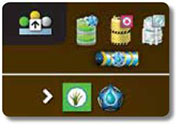
Example: If this farm next to connected city is upgraded, it also produces 1 point.
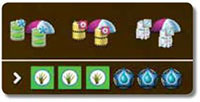
Example: If you have at least 2 upgraded farms at the same connected city, they will also produce 1 additional kelp and 1 additional point.
Things That Do Not Produce
A city will not produce if it is not connected to your network.
A building will not produce if it is not adjacent to a connected city.
A tunnel will not produce if it is not adjacent to a city (a tunnel connecting a metropolis with a Production effect will allow the metropolis to produce, but the metropolis does not help the tunnel produce).
Think of it like this: The connected cities are the places where people can live. It is the people who are doing the productive work. So a disconnected city will not produce because no one lives there - they can't move in until you complete a tunnel to it.
Similarly, a building next to an empty city site or a building next to a disconnected city does not have anyone there to run the operation. And tunnels that are not attached to any of your cities do not see enough traffic to produce.
Production from cards and Metropolises
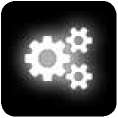
If you have claimed any production cards, or if you have connected your network to any metropolises with a production effect, you apply their effects at this time. When evaluating a production effect that depends on your cities or buildings, you always ignore cities and buildings that are not attached to your network.
Some production cards have no production of their own. Instead, they can modify the production of your tunnels, buildings, and cities. Such cards are evaluated when your network produces, and they do not apply to tunnels, buildings, and cities that do not produce.
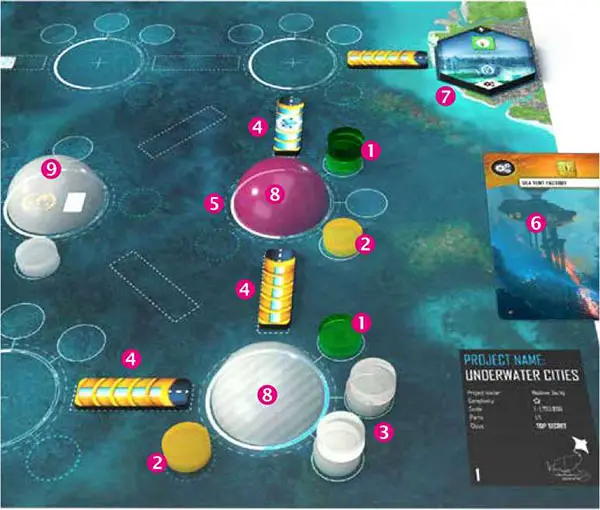
1 The two farms produce 2 kelp. The upgraded farm also produces 1 point.
2 The two desalination plants produce 2 credits. Neither has been upgraded, so they produce no biomatter.
3 Two upgraded laboratories at the same city produce 3 steelplast and 2 science.
Three tunnels are adjacent to cities, so they produce 3 credits. One is upgraded, so it also produces 1 point. 4 The fourth tunnel is not adjacent to a city. It produces nothing, but it does connect the metropolis to the network.
5 The symbiotic city is connected to the network, so it produces 2 points.
6 The production card produces 1 credit.
7 One metropolis is connected to the network. It produces 2 points.
8 After counting up production, the player must feed all cities connected to the network. Only two are connected, so the player pays 2 kelp.
9 The unconnected city is ignored during Production. Because no one lives there, its laboratory does not produce anything and it requires no kelp.
End of the Era
After everyone has resolved all production from all sources, it is time to resolve the end of the era with the following steps:
Rotate your action cards to the usual orientation to show they can be used in the next era (this step is unnecessary at the end of the final era).
Feed your cities (explained on the right).
Remove the old era's deck and discard pile from the game. Players keep any cards from that era that they currently have, but no more new ones will be drawn.
Shuffle the next era's deck and place it on the game board. This is the new draw pile. Each player draws 3 cards from the new era, adding them to any cards already in hand.
From this hand of 6 or more cards, choose 3 to keep and discard the rest. (Discarded cards from the new era go to the discard pile. Discarded cards from the previous era should be returned to that era's deck). Skip this step at the end of the final era.Advance the era marker.
Once everyone has discarded down to 3 cards, you are ready to play the next era with the new deck; or if you have completed the third era, you are ready for final scoring.

Hand Limit Summary:
You must discard down to 3 cards at the beginning of your turn and at the beginning of each era. At any other time, it is okay to have more than 3.
If a card increases your hand limit by one, then you must discard down to A cards at the beginning of your turn and at the beginning of each era. It is still possible that you will start one or more turns with only 3 cards, because this effect only alters the way you discard, not the way you draw.
Feeding Cities

At the end of Production, each city in your network must be fed 1 kelp (symbiotic cities have the same requirements as nonsymbiotic cities). Return this kelp to the general supply. If you have more cities than you have kelp, you spend all your kelp to feed those you can and then feed the remaining cities according to this chart:
For each unfed city, pay 1 biomatter. If any cities are still unfed, you feed them by paying points - 3 points per city at the end of each Production. If you lose all your points and still have unfed cities, just leave your scoring marker at 0, but it would be extremely unlikely to lose this many points unless you are deliberately trying to do so.
Only cities in your network require food. Cities that are not connected do not count as cities because they do not have people in them yet.
Final Scoring
Your underwater nation will score points throughout the course of the game, sometimes as the effect of certain cards, and sometimes during Production. At the end of the game, you may score points for a metropolis you have connected to or for specific cards you have claimed.
And finally, you will score points for the overall composition of your network and for your resources. The order of final scoring is depicted on your final scoring card.
Final Scoring
Final-Scoring Tile
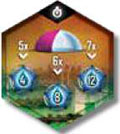
The metropolis in the upper left corner of your player board will give you points if you have connected it to your network with both tunnels.
End-Scoring Cards

Cards marked with this symbol can give you points at the end of the game. Some cards reward you for certain accomplishments. Others let you spend resources to buy points.
You should spend as much as you can - there is nothing else you can buy, and buying points via a card is always more efficient than keeping the resources and converting them into points after everything else has been scored.
Scoring Your Network
Your points are based on the number of different buildings next to each connected city:
- 2 points for a connected city with no buildings.
- 3 points for a connected city with 1 type of building.
- A points for a connected city with 2 types of buildings.
- 6 points for a connected city with all 3 types of buildings.
Scoring your Resources
Now, many of your remaining resources can be converted to points:
First, sell all your biomatter for 2 credits each.
Then buy 1 point for every A credits, kelp, science, or steelplast you spend, in any combination. (For example, 3 kelp and 1 steelplast is 1 point; 1 science, 2 steelplast, and 1 credit is 1 point; etc).
Leftover resources do not count. Convert all that you can, and ignore the remainder.
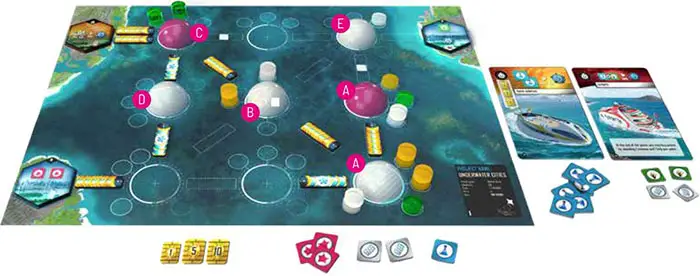
Example:
-
Because the brown metropolis is connected to the network by 2 tunnels, it can give points. Looking at the players' upgraded structures, we see 2 connected forms, 3 connected desalination plants, 3 connected laboratories, and 3 tunnels adjacent to cities. This counts as 2 full sets of qualifying upgraded structures, so the metropolis gives 8 points.
-
The player has 2 end-scoring cards that allow her to buy points. She spends 6 science to buy 9 points. She spends two pairs of kelp and steelplast to buy 2 points. This is 11 total points from end-scoring cards.
-
Now she counts points for cities and their structures. She scores 6 points for each city with 1 building of each type.
AShe has 2 of these, so that's 12 points.BHer city with two types of buildings is worth 4 points.CHer city with one type of building is worth 3 points. And her city with no buildings is still worth 2 points because it is connected. Her unconnected cityEis ignored. No one lives there, so it cannot give her points. In total, her cities give her 21 points. -
Her leftover resources can be converted to credits, or she can do this in her head. She has 16 credits, plus 2 more for steelplast, plus 1 more for science, plus 6 more for biomatter because those count as 2 credits each. Total credits is 25, which converts to 6 points. 1 credit is left over, but it will be ignored. If a tiebreaker is necessary, it is determined by what her position was on the Federation track at the end of the final round.
End of the Game
Whoever has the most points wins. If there is a tie, break the tie according to the tie-breaking play order that was determined at the end of the final round (politics pays).
But regardless of who has the most points, take the time to appreciate the extensive network of underwater cities you have built. Because of your efforts, millions of people now have food, water, and shelter. Great work!
Continue Reading

